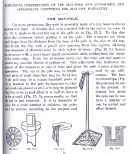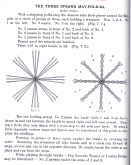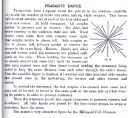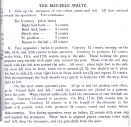Easiest
An ancient and easy May-pole is to designate a living tree such as this
‘witch tree’ in the Canary Islands. When I was in Northern Germany,
I saw a variation on this theme on the Rhine River. A tree in a yard outside
a tavern bloomed with yellow ribbons and bows.
The Witch Tree
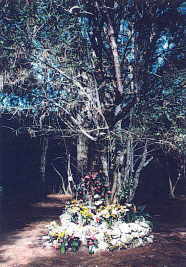
photo by Francisco Javier Garcia Miranda
Moderately difficult.
May-poles decorated with garlands is a standard theme. While this is more
difficult because construction is required, the decorations are done before
the celebration. Bedecked with garlands of flowers, this type of May-pole
would be ideal for young children to dance around.

Most difficult is the May-pole woven with ribbons, not because it is harder to construct or decorate than other types of May-poles, but because ribbon weaving dances are too complicated for children to accomplish. Two colors of ribbons are used and dancers alternate steps and directions. The following instructions and related dances were devised for college women who were willing and able to practice before their performance.
There is an important thing about beribboned May-poles -- the dancers expect an audience.
Easiest for young children.
In ancient Europe, the Mayday procession was a march around the village,
the marchers holding baskets, wreaths, May-poles or effigies. The stations
of the march would include village wells, barns where milk cows were housed,
and around the village boundaries. This can easily be adapted to a march
around the playground or park.

A little bit more difficult is “Thread the Needle,” a simple
procession of couples which somewhat resembles “The Stroll”
( an American teenage dance popular during the 1950’s) Children line
up, boys on one side, girls on the other. The couple on the end steps
forward, greet each other, then proceed to march through the lines. Another
variation is to have a flower and ribbon trimmed arch which the other
children march under.
More complicated, is dancing around the May-pole with
particular steps. Four sets of two place themselves at each ‘corner.’
The following sample quadrille is taken from “May-pole Possibilities.”
. Courtesy to partners, 4 counts.
. Courtesy to opposites, 4 counts.
. Form a circle and side-step to right, once around, and back again to
places.
. Grand right and left.
. Promenade all.
. Head couple form an archway, and all pass under: “Thread the Needle.”
Note the similarity between these steps and American barn dancing, or
square dancing. This dance is done around a May-pole decorated with garlands,
rather than plaited ribbons.
Most complicated is weaving ribbons around the May-pole. These instruction come from a book published in 1907. You will have to figure it out for yourselves. Good luck. It was performed by college students who practiced long, hard, and with enthusiasm.
What about music? The real answer is: anything goes. There has never been traditional tunes connected to Mayday, although the traditional English instruments are a pipe and a drum (played by the same person.) If you still need guidance on the matter, I will suggest the Virginia Reel or a formal waltz or ‘Comin’ Through the Rye’ I am posting some sheet music from my source books.
I hope these suggestions are useful. For the most part,
they were taken directly from the following out of print books:
May-pole Possibilities and
The Festival Book.
